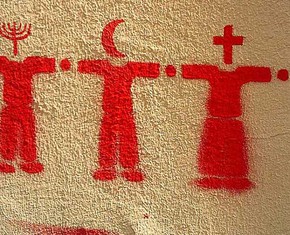The views expressed in our content reflect individual perspectives and do not represent the authoritative views of the Baha'i Faith.
As a kid, I used to sing “Jesus Loves Me,” at the loving request of my dear mother, before I went to sleep each night:
Jesus loves me! This I know,
For the Bible tells me so;
Little ones to Him belong;
They are weak, but He is strong.
Refrain:
Yes, Jesus loves me!
Yes, Jesus loves me!
Yes, Jesus loves me!
The Bible tells me so
– Anna B. Warner, “Jesus Loves Me” (1860).
 The verse “For the Bible tells me so” had a powerful influence on me growing up. I took the Bible seriously, as do millions of devoted Christians around the world. Taking the Bible seriously means taking the Bible literally—or does it?
The verse “For the Bible tells me so” had a powerful influence on me growing up. I took the Bible seriously, as do millions of devoted Christians around the world. Taking the Bible seriously means taking the Bible literally—or does it?
Growing up as a Christian, of course I had a very strong belief in Satan—and I believed in him literally. Satan fired up my imagination, stoked and fueled my deepest fears, and inflamed what I can best describe as a general anxiety. What else could I do? I had to believe in Satan—“For the Bible tells me so”—because the Bible is full of references to Satan:
Be sober, be vigilant; because your adversary the devil, as a roaring lion, walketh about, seeking whom he may devour. – 1 Peter 5:8.
Then shall he say also unto them on the left hand, Depart from me, ye cursed, into everlasting fire, prepared for the devil and his angels. – Matthew 25:41.
And the great dragon was cast out, that old serpent, called the Devil, and Satan, which deceiveth the whole world: he was cast out into the earth, and his angels were cast out with him. – Revelation 12:9.
Here, the Bible describes Satan as a “great dragon,” an “old serpent,” and a “roaring lion.” So I figured that since Satan is a great shape-shifter—assuming different animal guises at will—I had to be vigilant, and on a constant lookout. Like the 1963 hit single by Elvis Presley, “(You’re the) Devil in Disguise,” I was scared that Satan could be lurking anywhere and everywhere, for, as St. Paul warned: “And no marvel; for Satan himself is transformed into an angel of light.” – 2 Corinthians 11:14.
So what if these Biblical passages about Satan are to be taken as metaphorical and symbolic? What if Satan isn’t an actual being, but a symbol and a metaphor?
After becoming a Baha’i, I realized that a Christian belief in Jesus Christ, in a sense, also entailed a belief in the existence of Satan as part of the Christian metaphysical universe, as I understood it at that time. In short, I started doubting the devil after I became a Baha’i. This was not easy to do, but I can never undo it. Why? Because I was finally liberated from my so-called “Christian” belief in Satan, which I am no longer bound by. For me, Satan is a superstition. My former belief in Satan is now disenchanted.
While I continue to believe in Jesus Christ, as all Baha’is do, I no longer believe that “Satan” exists, beyond being a personification and symbol of human evil—which is all too real. Belief in Satan as a power, person and or principality distracts from the real problem. Satan did not create evil. Humans did, and still do. See Satan’s Epitaph:
So let’s take a look at Satan in prophecy, and let’s see if we can figure this out:
11 And I saw heaven opened, and behold a white horse; and he that sat upon him was called Faithful and True, and in righteousness he doth judge and make war.
12 His eyes were as a flame of fire, and on his head were many crowns; and he had a name written, that no man knew, but he himself.
13 And he was clothed with a vesture dipped in blood: and his name is called The Word of God.
14 And the armies which were in heaven followed him upon white horses, clothed in fine linen, white and clean.
15 And out of his mouth goeth a sharp sword, that with it he should smite the nations: and he shall rule them with a rod of iron: and he treadeth the winepress of the fierceness and wrath of Almighty God.
16 And he hath on his vesture and on his thigh a name written, King Of Kings, And Lord Of Lords.
17 And I saw an angel standing in the sun; and he cried with a loud voice, saying to all the fowls that fly in the midst of heaven, Come and gather yourselves together unto the supper of the great God;
18 That ye may eat the flesh of kings, and the flesh of captains, and the flesh of mighty men, and the flesh of horses, and of them that sit on them, and the flesh of all men, both free and bond, both small and great.
19 And I saw the beast, and the kings of the earth, and their armies, gathered together to make war against him that sat on the horse, and against his army.
20 And the beast was taken, and with him the false prophet that wrought miracles before him, with which he deceived them that had received the mark of the beast, and them that worshipped his image. These both were cast alive into a lake of fire burning with brimstone.
21 And the remnant were slain with the sword of him that sat upon the horse, which sword proceeded out of his mouth: and all the fowls were filled with their flesh. – Revelation 19:11–21.
So one basic approach in figuring out prophecy—what this series is all about—is to rule out any and all literal interpretations that are not only physically impossible, but are morally repugnant.
An “angel” summoning “all the fowls that fly in the midst of heaven” to a great feast — oddly dubbed “the supper of the great God” — to gorge on “the flesh of all men, both free and bond, both small and great” is not only gory and gruesome, but is cruel and unjust punishment as well — and unduly vengeful, unworthy of God.
Any interpretation that involves Christian behavior that is morally forbidden by well-established Christian ethics cannot abide. Any and all such literal interpretations must therefore be discarded.
Another word of caution: if prophecy doesn’t make sense literally and/or ethically, then better not to interpret that prophecy literally. Take, for instance, this catch-and-release scenario:
7 And when the thousand years are expired, Satan shall be loosed out of his prison,
8 And shall go out to deceive the nations which are in the four quarters of the earth, Gog, and Magog, to gather them together to battle: the number of whom is as the sand of the sea.
9 And they went up on the breadth of the earth, and compassed the camp of the saints about, and the beloved city: and fire came down from God out of heaven, and devoured them.
10 And the devil that deceived them was cast into the lake of fire and brimstone, where the beast and the false prophet are, and shall be tormented day and night for ever and ever. – Revelation 20:7–10.
What the heck is going on here? At first, Satan and his host are “cast alive into a lake of fire burning with brimstone.” Then, after a thousand years, “Satan shall be loosed out of his prison.”
Who did that? What sense does that make? How is justice and righteousness served by this? Fortunately, “the devil that deceived them was cast into the lake of fire and brimstone … and shall be tormented day and night for ever and ever.”
The Book of Revelation is written in secret code—one rife with metaphor and symbolic meaning. A secret code has be to deciphered in order to be understood. So don’t be fooled by those who say that you have to take the Bible literally.
The Baha’i teachings say this about the Book of Revelation:
Meditate then upon the utterance of one of the Prophets as He intimated to the souls of men, through veiled allusions and hidden symbols, the glad-tidings of the One Who was to come after Him, that thou mayest know of a certainty that their words are inscrutable to all save those who are endued with an understanding heart. He saith: “His eyes were as a flame of fire”, and “brass-like were His feet”, and “out of His mouth goeth a two-edged sword”. [Rev. 1:14–16; 2:18; 19:15.] How could these words be literally interpreted? Were anyone to appear with all these signs, he would assuredly not be human. And how could any soul seek his company? Nay, should he appear in one city, even the inhabitants of the next would flee from him, nor would any soul dare approach him! Yet, shouldst thou reflect upon these statements, thou wouldst find them to be of such surpassing eloquence and clarity as to mark the loftiest heights of utterance and the epitome of wisdom. Methinks it is from them that the suns of eloquence have appeared and the stars of clarity have dawned forth and shone resplendent. – Baha’u’llah, Gems of Divine Mysteries, pp. 52–53.
So here’s a rule-of-thumb when you want to figure out prophecy: Beware of false prophecies—meaning false interpretations of prophecies— if their literal interpretations contradict science, reason, ethics, human decency and justice.
You May Also Like
Comments

















We have a whole series of best-selling novels called the “Left Behind” series, imagining what will happen on earth after the “Rapture.” This apparently makes good sense to people even though Revelation makes no mention of a rapture, and in fact the notion was invented only in the nineteenth century. But because it has become such a part of our world in front of the text, people see it in the text. In the same way, most of my students are so immersed in readings ...like Hal Lindsay’s The Late Great Planet Earth that they think that that is what the story says. But of course it is not.
—David L. Barr, “Beyond Genre: The Expectations of Apocalypse,” p. 73.
Devil is not a monster waiting to trap us,
He is a voice inside.
Look for Your Devil in Yourself,
not in the Others.
Don’t forget that the one who knows his Devil,
knows his God.” – Shams Tabrizi